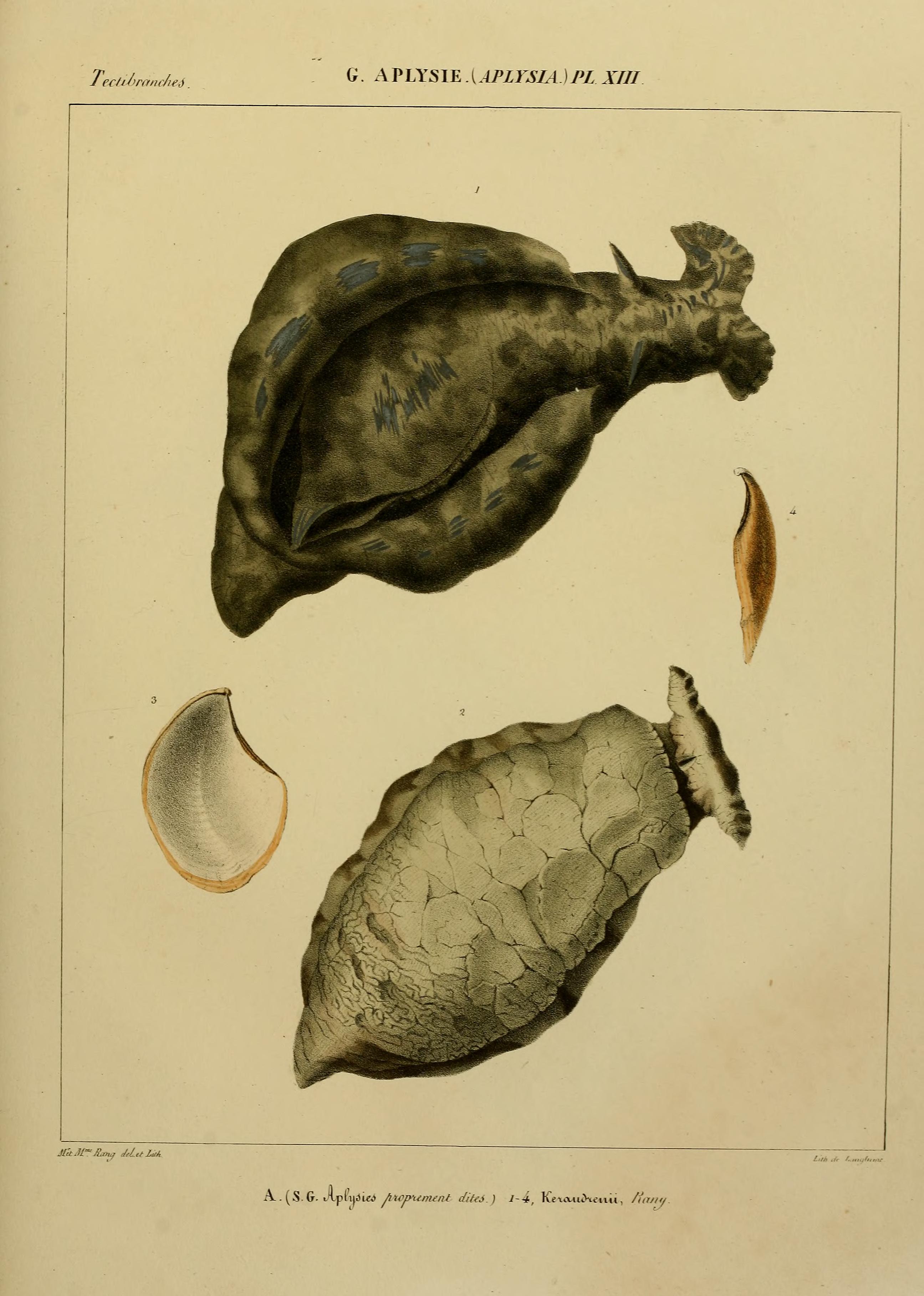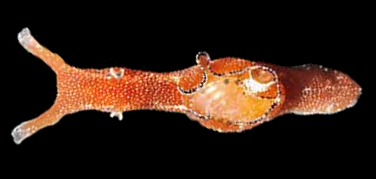|
Dolabrifera Dolabrifera
''Dolabrifera dolabrifera'' is a species of sea hare, a marine gastropod mollusc in the family Aplysiidae, the sea hares. ''Dolabrifera dolabrifera,'' otherwise known as a ''Warty Seacat.'' The animal goes by many names, including the common sea hare. The Hawaiian name for ''Dolabrifera dolabrifera, is Kualakai.'' Description & Biology The Seacat is a flat sea hare that grows to about 10 cm long. The maximum recorded length is 108 mm. It is commonly spotty green or brown, but it can also be reddish. The animal's back half is typically wider and rounded, it narrows towards the head. Warty Seacats are soft-bodied gastropods The gastropods (), commonly known as snails and slugs, belong to a large taxonomic class of invertebrates within the phylum Mollusca called Gastropoda (). This class comprises snails and slugs from saltwater, from freshwater, and from land. Ther ..., who have lost a protective shell over time. All species of sea hares have ink glands for chemic ... [...More Info...] [...Related Items...] OR: [Wikipedia] [Google] [Baidu] |
Sander Rang
Sander Rang or Paul Charles Leonard Alexander Rang (1793, Utrecht -1844, Mayotte) was a French conchologist and interpreter of Arabic texts. He was, in 1816, one of the survivors of the sinking of the frigate ''Medusa'', on which he was an ensign. He spent a good part of his life in La Rochelle, where he published his early zoological observations, in particular in the bulletins of the Society of Natural Sciences of Charente-Maritimes.In 1841 Rang was one of the founding members of the Société des Amis des Arts now the Musée des Beaux-Arts de La Rochelle.He specialised in marine fauna notably in sea hares, cephalopods and other molluscs and on the heterogenous group known as zoophytes. Sander Rang described many new mollusc species including the sea hares ''Aplysia dactylomela'', '' Dolabrifera dolabrifera'', the cuttlefish ''Sepia hierredda'' and the land snails ''Striosubulina striatella'', '' Pleurodonte desidens '' and ''Opeas hannense''. Biography Sander Rang was b ... [...More Info...] [...Related Items...] OR: [Wikipedia] [Google] [Baidu] |
Aplysiidae
Aplysiidae is the only family in the superfamily Aplysioidea, within the clade Anaspidea. These animals are commonly called sea hares because, unlike most sea slugs, they are often quite large, and when they are underwater, their rounded body shape and the long rhinophores on their heads mean that their overall shape resembles that of a sitting rabbit or hare. Sea hares are however sea snails with shells reduced to a small plate hidden between the parapodia, and some species are extremely large. The Californian black sea hare, ''Aplysia vaccaria'' is arguably the largest living gastropod species, and is certainly the largest living heterobranch gastropod. Description Members of the Aplysiidae have an atrophied inner shell (in contrast with the nudibranchs, which have no shell at all). In ''Aplysia'' and ''Syphonota'', this shell is a soft flattened plate over the visceral rear end, where it is fully or partially enclosed in the mantle skin. In ''Dolabella auricularia'', t ... [...More Info...] [...Related Items...] OR: [Wikipedia] [Google] [Baidu] |
Arthur William Baden Powell
Arthur William Baden Powell (4 April 1901 – 1 July 1987) was a New Zealand malacologist, naturalist and palaeontologist, a major influence in the study and classification of New Zealand molluscs through much of the 20th century. He was known to his friends and family by his third name, "Baden". Biography Early life The name Baden had been a given name in a Powell family since 1731, when Susannah Powell née Thistlethwayte (1696–1762) gave to her child (1731–1792) the maiden name of her mother, Susannah Baden (1663–1692). The name Baden, particularly when associated with the surname Powell, became famous in 1900–1901, the year Arthur William Baden Powell was born, because of the siege of Mafeking, the most famous British action in the Second Boer War, which turned the British commander of the besieged, Robert Baden-Powell, into a national hero. Throughout the British Empire, babies were named after him. No family connection has yet been established between Arthur W ... [...More Info...] [...Related Items...] OR: [Wikipedia] [Google] [Baidu] |
Dolabrifera2
''Dolabrifera'' is a genus of sea hares, a taxonomic group of sea slugs or marine opisthobranch gastropod mollusks belonging to the family Aplysiidae.Bouchet, P.; Gofas, S. (2011). ''Dolabrifera'' Gray, 1847. Accessed through: World Register of Marine Species at http://www.marinespecies.org/aphia.php?p=taxdetails&id=137901 on31 March 2012 Species Species within the genus ''Dolabrifera'' include: * '' Dolabrifera brazieri'' Sowerby, 1870 * ''Dolabrifera dolabrifera ''Dolabrifera dolabrifera'' is a species of sea hare, a marine gastropod mollusc in the family Aplysiidae, the sea hares. ''Dolabrifera dolabrifera,'' otherwise known as a ''Warty Seacat.'' The animal goes by many names, including the common sea ...'' (Rang, 1828) * '' Dolabrifera fusca'' Pease, 1868 * '' Dolabrifera holboelli'' Bergh, 1872: ''species inquirenda'' * '' Dolabrifera jacksoniensis'' Pilsbry, 1896 * '' Dolabrifera vitraea'' G.B. Sowerby II, 1868 ; Species brought into synonymy: * ''Dolabrifera ascifera ... [...More Info...] [...Related Items...] OR: [Wikipedia] [Google] [Baidu] |
Gastropoda
The gastropods (), commonly known as snails and slugs, belong to a large taxonomic class of invertebrates within the phylum Mollusca called Gastropoda (). This class comprises snails and slugs from saltwater, from freshwater, and from land. There are many thousands of species of sea snails and slugs, as well as freshwater snails, freshwater limpets, and land snails and slugs. The class Gastropoda contains a vast total of named species, second only to the insects in overall number. The fossil history of this class goes back to the Late Cambrian. , 721 families of gastropods are known, of which 245 are extinct and appear only in the fossil record, while 476 are currently extant with or without a fossil record. Gastropoda (previously known as univalves and sometimes spelled "Gasteropoda") are a major part of the phylum Mollusca, and are the most highly diversified class in the phylum, with 65,000 to 80,000 living snail and slug species. The anatomy, behavior, feeding, a ... [...More Info...] [...Related Items...] OR: [Wikipedia] [Google] [Baidu] |
Soft-bodied Organism
Soft-bodied organisms are animals that lack skeletons. The group roughly corresponds to the group Vermes as proposed by Carl von Linné. All animals have muscles but, since muscles can only pull, never push, a number of animals have developed hard parts that the muscles can pull on, commonly called skeletons. Such skeletons may be internal, as in vertebrates, or external, as in arthropods. However, many animals groups do very well without hard parts.Ruppert, E. E.; Fox, R. S.; Barnes, R. D. (2004) ''Invertebrate Zoology'' (7th ed.). Brooks / Cole. This include animals such as earthworms, jellyfish, tapeworms, squids and an enormous variety of animals from almost every part of the kingdom Animalia. Commonality Most soft-bodied animals are small, but they do make up the majority of the animal biomass. If we were to weigh up all animals on Earth with hard parts against soft-bodied ones, estimates indicate that the biomass of soft-bodied animals would be at least twice that of animal ... [...More Info...] [...Related Items...] OR: [Wikipedia] [Google] [Baidu] |
Family (biology)
Family ( la, familia, plural ') is one of the eight major hierarchical taxonomic ranks in Linnaean taxonomy. It is classified between order and genus. A family may be divided into subfamilies, which are intermediate ranks between the ranks of family and genus. The official family names are Latin in origin; however, popular names are often used: for example, walnut trees and hickory trees belong to the family Juglandaceae, but that family is commonly referred to as the "walnut family". What belongs to a family—or if a described family should be recognized at all—are proposed and determined by practicing taxonomists. There are no hard rules for describing or recognizing a family, but in plants, they can be characterized on the basis of both vegetative and reproductive features of plant species. Taxonomists often take different positions about descriptions, and there may be no broad consensus across the scientific community for some time. The publishing of new data and opini ... [...More Info...] [...Related Items...] OR: [Wikipedia] [Google] [Baidu] |
Georges Cuvier
Jean Léopold Nicolas Frédéric, Baron Cuvier (; 23 August 1769 – 13 May 1832), known as Georges Cuvier, was a French natural history, naturalist and zoology, zoologist, sometimes referred to as the "founding father of paleontology". Cuvier was a major figure in natural sciences research in the early 19th century and was instrumental in establishing the fields of comparative anatomy and paleontology through his work in comparing living animals with fossils. Cuvier's work is considered the foundation of vertebrate paleontology, and he expanded Linnaean taxonomy by grouping classes into phylum, phyla and incorporating both fossils and living species into the classification. Cuvier is also known for establishing extinction as a fact—at the time, extinction was considered by many of Cuvier's contemporaries to be merely controversial speculation. In his ''Essay on the Theory of the Earth'' (1813) Cuvier proposed that now-extinct species had been wiped out by periodic catastrophi ... [...More Info...] [...Related Items...] OR: [Wikipedia] [Google] [Baidu] |
Mollusc
Mollusca is the second-largest phylum of invertebrate animals after the Arthropoda, the members of which are known as molluscs or mollusks (). Around 85,000 extant species of molluscs are recognized. The number of fossil species is estimated between 60,000 and 100,000 additional species. The proportion of undescribed species is very high. Many taxa remain poorly studied. Molluscs are the largest marine phylum, comprising about 23% of all the named marine organisms. Numerous molluscs also live in freshwater and terrestrial habitats. They are highly diverse, not just in size and anatomical structure, but also in behaviour and habitat. The phylum is typically divided into 7 or 8 taxonomic classes, of which two are entirely extinct. Cephalopod molluscs, such as squid, cuttlefish, and octopuses, are among the most neurologically advanced of all invertebrates—and either the giant squid or the colossal squid is the largest known invertebrate species. The gastropods ... [...More Info...] [...Related Items...] OR: [Wikipedia] [Google] [Baidu] |






